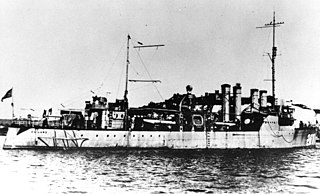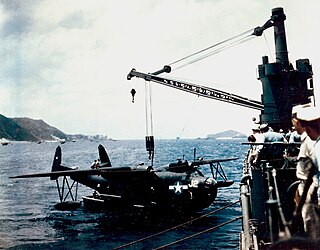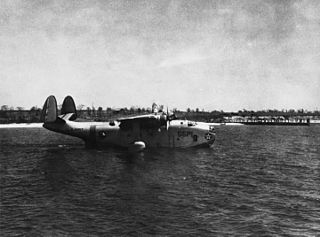Related Research Articles

USS Juneau (CL-52) was a United States Navy Atlanta-class light cruiser torpedoed and sunk at the Naval Battle of Guadalcanal on 13 November 1942. In total, 687 officers and sailors, including the five Sullivan brothers, were killed in action as a result of her sinking. Only 10 survivors were rescued after eight days in the water. To honor the five Sullivan brothers and Juneau, the U.S. Navy has since commissioned two ships named USS The Sullivans and two ships named USS Juneau. On 17 March 2018, Paul Allen's research crew on board RV Petrel located the wreck of Juneau at a depth of about 4,200 m (13,800 ft) off the Solomon Islands.

The Martin PBM Mariner was a twin-engine American patrol bomber flying boat of World War II and the early Cold War era. It was designed to complement the Consolidated PBY Catalina and PB2Y Coronado in service. A total of 1,366 PBMs were built, with the first example flying on February 18, 1939, and the type entering service in September 1940, with the last of the type being retired in 1964.

The second USS Ballard (DD-267/AVD-10) was a Clemson-class destroyer in the United States Navy during World War II. She was named for Edward J. Ballard.

USS Onslow (AVP-48) was a United States Navy Barnegat-class seaplane tender in commission from 1943 to 1947 and from 1951 to 1960.

USS Yakutat (AVP-32) was a United States Navy Barnegat-class small seaplane tender in commission from 1944 to 1946. Yakutat tended seaplanes in combat areas in the Pacific during the latter stages of World War II. After the war, she was in commission in the United States Coast Guard from 1948 to 1971 as the Coast Guard cutter USCGC Yakutat (WAVP-380), later WHEC-380, seeing service in the Vietnam War during her Coast Guard career. Transferred to South Vietnam in 1971, she was commissioned into the Republic of Vietnam Navy as the frigate RVNS Trần Nhật Duật (HQ-03). When South Vietnam collapsed in 1975 at the end of the Vietnam War, she fled to the Philippines, where the Philippine Navy took custody of her and cannibalized her for spare parts until discarding her in 1982.

USS Bering Strait (AVP-34) was a United States Navy Barnegat-class small seaplane tender in commission from 1944 to 1946. She tended seaplanes during World War II in the Pacific in combat areas and earned three battle stars by war's end.

The second USS Orca (AVP-49) was a United States Navy seaplane tender in commission from 1944 to 1947 and from 1951 to 1960. She saw service during the latter stages of World War II and during the Cold War. In 1962 she was loaned to Ethiopia, where she served in the Ethiopian Navy as the training ship Ethiopia (A-01) until 1991. She was the Ethiopian Navy's largest ship until she was sold for scrapping in 1993.
VA-194 was an Attack Squadron of the U.S. Navy. It was established as Bombing Squadron VB-19 on 15 August 1943. It was redesignated as VA-19A on 15 November 1946, and as VA-194 on 24 August 1948. The squadron was disestablished on 1 December 1949. Its nickname is unknown.
VP-48 was a Patrol Squadron of the U.S. Navy. It was established as VP-208 on 15 December 1942, redesignated Patrol Bombing Squadron VPB-208 on 1 October 1944, redesignated VP-208 on 15 May 1946, redesignated Medium Patrol Squadron (Seaplane) VP-MS-8 on 15 November 1946, redesignated VP-48 on 1 September 1948 and disestablished on 31 December 1949. It was the first squadron to be assigned the VP-48 designation. A second VP-48 was established in May 1946 and disestablished on 23 May 1991.

VP-26 was a Patrol Squadron of the U.S. Navy. The squadron was established as Patrol Squadron 26 (VP-26) on 1 May 1944, redesignated Patrol Bombing Squadron 26 (VPB-26) on 1 October 1944, redesignated Patrol Squadron 26 (VP-26) on 15 May 1946 and disestablished on 14 December 1946. It was the second squadron to be designated VP-26, the first VP-26 was redesignated VP-14 on 1 July 1941.

VP-40 was a Patrol Squadron of the U.S. Navy. The squadron was established as Patrol Squadron 55 (VP-55) on 1 August 1940, redesignated Patrol Squadron 74 (VP-74) on 1 July 1941, redesignated Patrol Bombing Squadron 74 (VPB-74) on 1 October 1944, redesignated Patrol Squadron 74 (VP-74) on 15 May 1946, redesignated Medium Patrol Squadron (Seaplane) 10 (VP-MS-10) on 15 November 1946, redesignated Patrol Squadron 40 (VP-40) on 1 September 1948 and disestablished on 25 January 1950.
VP-41 was a Patrol Squadron of the U.S. Navy. The squadron was established as Patrol Squadron 21 (VP-21) on 1 March 1944, redesignated Patrol Bombing Squadron 21 (VPB-21) on 1 October 1944, redesignated Patrol Squadron 21 (VP-21) on 15 May 1946, redesignated Medium Patrol Squadron (Seaplane) 11 (VP-MS-11) on 15 November 1946, redesignated Patrol Squadron 41 (VP-41) on 1 September 1948 and disestablished on 23 April 1949.
VPB-16 was a Patrol Bombing Squadron of the U.S. Navy. The squadron was established as Patrol Squadron 16 (VP-16) on 20 December 1943, redesignated Patrol Bombing Squadron 16 (VPB-16) on 1 October 1944 and disestablished on 30 June 1945.
VPB-100 was a Patrol Bombing Squadron of the U.S. Navy. The squadron was established as Patrol Squadron 100 (VP-100) on 1 April 1944, redesignated Patrol Bombing Squadron 100 (VPB-100) on 1 October 1944 and disestablished on 15 December 1945.

VPB-203 was a Patrol Bombing Squadron of the U.S. Navy. The squadron was established as Patrol Squadron Two Hundred Three (VP-203) on 1 October 1942, redesignated Patrol Bombing Squadron Two Hundred Three (VPB-203) on 1 October 1944 and disestablished on 30 June 1945.

VH-3 was one of six dedicated VH rescue squadrons of the U.S. Navy during WW II. Prior to their creation, the rescue function was performed as an additional "spur of the moment" duty by regularly operating patrol squadrons. The Fleet Commanders made clear "that the men who risked their lives to rocket, bomb, and strafe the enemy wherever and whenever possible, should under no circumstances, be left to fend for themselves when disaster struck them." After the war the Japanese related that they could not understand why so much was risked to save airmen. This was a tremendous morale builder for the flyers, but there was a cold calculated logic behind this as well. It meant that very expensively trained and experienced aviators could be rescued from a watery grave or brutal captivity and put back into the fight. American aircrews captured after being shot down over the Japanese home islands faced a grim fate. VH-3 squadron members related "how intense, intense every crew member became .. over this business of saving lives", "the marvelous feeling of reward when saving a downed pilot's life", and "nose-thumbing at the Japanese military .. when we swiped near-prisoners under their eye".
VH-1 was one of six dedicated (VH) Rescue Squadrons of the U.S. Navy during WWII. VH-1 made 19 direct rescues via open sea landings. It also assisted in the rescue of another 119 air crewman by locating them and directing surface vessels to effect the rescue. VH-1 was established on 1 February 1944 and disestablished in April 1946. The squadron employed the Consolidated PB2Y Coronado and the Martin PBM Mariner during its operations.
VH-4 was one of six dedicated (VH) rescue squadrons of the U.S. Navy during World War II. VH-4 made 42 rescues of downed aviators, nine rescues of Filipino civilians and assisted in the rescue of another aviator. VH-4 was established in September 1944 and disestablished in November1946. The squadron employed the Martin PBM Mariner during its operations.
VH-6 was one of six dedicated Rescue Squadrons of the U.S. Navy during WWII. In the final week of the war, VH-6 rescued 13 aviators off the coast of Japan. VH-6 was established in January 1945 and disestablished in February 1946. The squadron employed the Martin PBM Mariner during its operations.
VH-2 was one of six dedicated Rescue Squadrons of the U.S. Navy during World War II. VH-2 was established in August 1944 and disestablished in November 1945. Unlike the other VH squadrons, VH-2 mostly employed the PB2B Catalina during its wartime operations. Late in the war, the PB2B Catalina was no longer used for open sea rescues, since it had proven less rugged in the open sea than its successor the Martin PBM Mariner. Thus VH-2's primary mission was to "spot" survivors in the water and direct other craft to the site to effect the rescue. On at least two occasions, VH-2 did effect rescues with open sea landings. VH-2 was credited with the initial spotting, direct rescue, or assistance in the rescue of 96 downed bomber crewman. After the war, they were assigned the Martin PBM Mariner.
References
- ↑ Gintner, Steve (2013). Martin PBM Mariner (Naval Fighters Number 97). Simi Valley, Ca: Steve Gintner, First Edition. p. 146. ISBN 0989258327.
- ↑ "Page 1 WWII War Diaries - Fold3". Fold3. Retrieved 2017-01-26.
- ↑ "Page 2 WWII War Diaries - Fold3". Fold3. Retrieved 2017-01-26.
- ↑ "Page 3 WWII War Diaries - Fold3". Fold3. Retrieved 2017-01-26.
- ↑ "Page 4 WWII War Diaries - Fold3". Fold3. Retrieved 2017-01-26.
- ↑ "Page 3 WWII War Diaries - Fold3". Fold3. Retrieved 2017-01-26.
- ↑ "Page 3 WWII War Diaries - Fold3". Fold3. Retrieved 2017-01-26.
- ↑ "Page 2 WWII War Diaries - Fold3". Fold3. Retrieved 2017-01-26.
